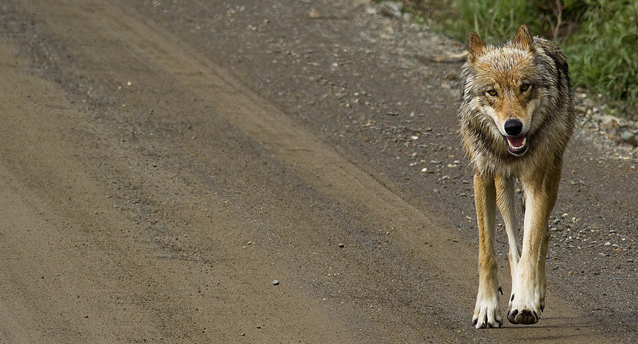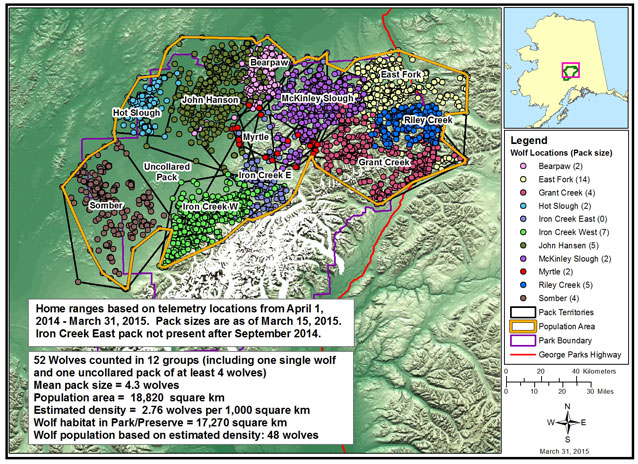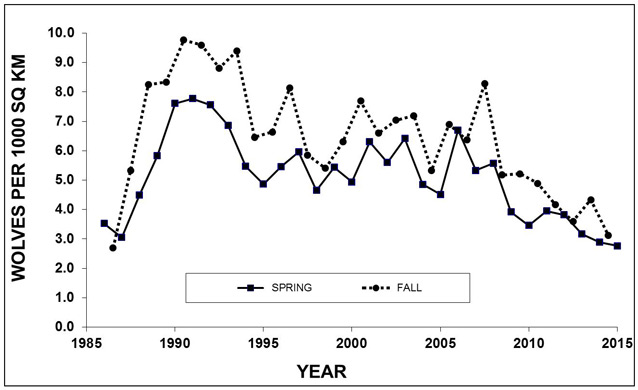
NPS Photo / Nathan Kostegian
Denali National Park and Preserve’s wolves have been studied by researchers since 1939. Population estimates were not very accurate until 1986, when a large-scale wolf research project was initiated by David Mech and others. This project provided basic information necessary for effective wolf management. The current monitoring program consists of maintaining one or two radio-collared wolves in each known pack inhabiting the park north of the Alaska Range. Radio-collared wolves are located about twice per month, with additional locations during late September to early October to determine fall pack sizes and to count pups, and during March to determine late winter pack sizes. Telemetry locations acquired over one year (April—March) are used to determine the area of each pack territory. Counts of wolves in these packs and the area encompassed by the combined pack territories are used to estimate abundance and density of wolves. In addition, monitoring data are used to determine wolf movements, den locations, mortality factors, behavior, and population dynamics.
During 2014 – 2015, we monitored a total of 20 radio-collared wolves from 10 packs with territories at least partly within Denali (Figure 1). Two types of collars were used. Four wolves wore conventional VHF radio collars. Another 16 wolves carried GPS collars that determine the animal’s location one or more times per day and transmit the data through the ARGOS satellite system.

In March 2015, the 10 marked packs included 47 wolves, and their combined territories covered an area of 18,820 square kilometers. An additional lone wolf was collared in March 2015, and tracks of an uncollared pack of at least 4 wolves were also detected. The total of 52 wolves (including the uncollared pack) counted in March 2015 produced an estimated density of 2.8 wolves per 1,000 square kilometers, which is the lowest density estimate since monitoring began in 1986 (Figure 1). The increased use of GPS collars during the past 10 years has improved our ability to estimate territory size, and consequently the estimate of the combined area occupied by wolves in our study area has generally increased. This partly explains why the current density estimate is low. However, the number of wolves actually counted each year has also declined, despite similar levels of monitoring effort, so it appears that the population has declined from levels seen during 2001 – 2003 (5.6 – 6.4 wolves per 1,000 square kilometers). Causes of the population decline are unknown, although several factors may be involved. These include low snowfall during the past several winters, which has reduced the vulnerability of caribou and moose to wolf predation, relatively poor pup recruitment, and mortality of wolves from both human and natural causes.

In 2014, at least 6 of the 10 collared packs denned and produced a minimum of 14 pups that survived until fall. One young male wolf from the East Fork pack, collared in December 2013, dispersed over 200 miles from Denali, eventually settling down in Yukon-Charlie National Preserve. Details of this trip were posted online as a science summary. Nine collared adult wolves died during 2014 – 2015; two were killed by other wolves, one died of apparent old age, one drowned, one starved, and one was legally shot by a trapper outside the park. Cause of death could not be determined for two wolves, although there was no evidence of human involvement. One young male wolf died during late February 2015, after becoming caught in a snare set outside the park. The wolf was able to break free from the snare’s anchor wire and return to the park, but subsequently died due to blood loss caused by the snare. The Iron Creek East pack disappeared after both collared adult wolves died in September 2014. The breeding female died of starvation and her mate subsequently dispersed eastward. He evidently drowned while crossing the Toklat River, which was swollen from recent heavy rains. A new pair was located and radiocollared in the range previously occupied by this pack during March 2015. This pair was dubbed the Myrtle pack.
During early March 2015 we captured and radiocollared 13 wolves. These included 11 new wolves and 2 collared wolves that were recaptured to replace their radiocollars. Five of the new wolves were young males. These were equipped with newly-developed collars that include three-dimensional accelerometers, which enable researchers to determine the animals’ activity (e.g., running, walking, resting) as well as their locations. One of the new captures, a lone male wolf, exhibited an abnormal condition known as follicular dysplasia, also known as “poodle coat”. This condition is characterized by loss of the long guard hairs from much of the wolf’s body, resulting in a wooly appearance due to the dense, short underfur that remains. This wolf died approximately March 31, evidently due to starvation. As of early May 2015, 3 additional wolves were known to have died. One of these was a collared male that was killed by other wolves. The others were a collared male and an uncollared female from the East Fork pack that were legally shot by a hunter outside of the park near the Stampede Trail. GPS data provided by the male wolf’s collar indicated that he had spent most of the week before his death scavenging at a bait station established by a bear hunter within a mile of the location where he was shot.
Last updated: March 17, 2016
